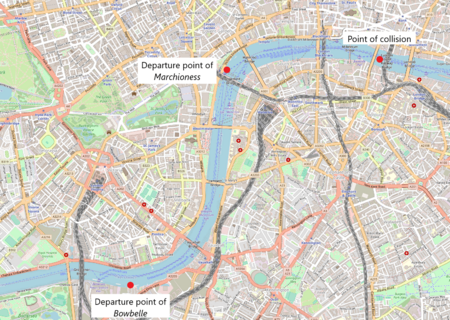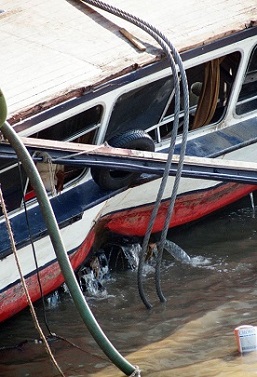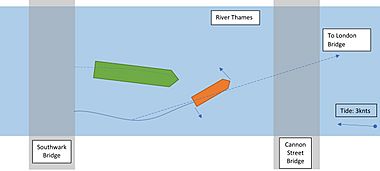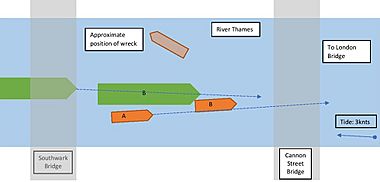Marchioness disaster facts for kids

The Marchioness disaster was a terrible accident on the River Thames in London. In the early hours of 20 August 1989, a pleasure boat called Marchioness crashed with a large dredger called Bowbelle. This happened near Cannon Street railway bridge and Southwark Bridge. The Marchioness sank very quickly, and 51 people sadly lost their lives.
The Marchioness had been rented for a birthday party and had about 130 people on board. Both boats were moving downstream, against the river's flow. The Bowbelle was much faster and bigger than the Marchioness. Investigators believe the Bowbelle hit the Marchioness from behind, causing it to turn. Then, the Bowbelle hit it again, pushing the smaller boat under the water. The Marchioness sank in just 30 seconds.
After the accident, an investigation looked into what happened. It found that neither boat had a good lookout system. This meant they didn't see each other in time to avoid the crash. The families of the victims pushed for more investigations, and eventually, a big inquiry was held in 2000. This inquiry also found that poor lookout on both boats was the main reason for the collision. It also criticized the owners of the boats and the authorities responsible for river safety. Because of this disaster, new safety rules were put in place on the Thames, and four new lifeboat stations were added to help keep people safe.
About the Boats
The Marchioness
The Marchioness was a pleasure boat built in 1923. She was 85.5 ft (26.1 m) long and 14.5 ft (4.4 m) wide. For most of her life, she sailed on the River Thames. During World War II, she even helped in the 1940 Dunkirk evacuation, rescuing soldiers.
Later, in 1978, the Marchioness was rebuilt. An upper deck was added, which made it harder to see from the captain's steering area. Also, there weren't many easy ways to get out in an emergency, especially from the lower parts of the boat. The Marchioness had seven life rafts and seven lifebuoys for safety. She was allowed to carry up to 165 passengers. In the 1970s, more boats were used for evening parties and discos, and the Marchioness was one of them.
On the night of the accident, the Marchioness had a captain, Stephen Faldo, and a mate, Andrew McGowan. They also had two bar staff. Stephen Faldo was 29 and had worked on the Thames since he was 17. Andrew McGowan was 21 and had also trained to work on the river.
The Bowbelle
The Bowbelle was a large dredger ship, launched in 1964. She was 262 ft (79.9 m) long and 45 ft (13.8 m) wide. The Bowbelle was one of six "Bow" ships used for carrying sand and gravel. Her crew included a captain, two mates, engineers, and seamen. The captain of the Bowbelle was Douglas Henderson, who was 31 years old.
Before this accident, other ships from the same company, including the Bowbelle itself, had been involved in previous incidents on the Thames. For example, the Bowbelle had hit Cannon Street railway bridge in 1982.
On the night of the collision, the Bowbelle was carrying sand and gravel. This, along with its dredging equipment, made it hard to see clearly from the ship's steering area.
The Night of the Collision
The night of 19–20 August 1989 was clear with good visibility and very little wind. The river had a strong tide, which was flowing upstream.
The Bowbelle left its dock near Battersea Power Station at 1:12 am. It told the Thames Navigation Service (TNS) that it was moving downstream. The TNS then warned all other boats on the river about the Bowbelle's journey. The Bowbelle was moving at about 5.5 knots (6.3 mph; 10.2 km/h) over the ground.
The Marchioness left Embankment Pier at 1:25 am. There were about 130 or 131 people on board. The Marchioness was moving slower, at about 3.2 knots (3.7 mph; 5.9 km/h) over the ground. As it went downriver, it passed another pleasure boat, the Hurlingham, which was also having a disco party.
At some point after Blackfriars Bridge, the Bowbelle passed the Hurlingham and headed for the middle arch of Southwark Bridge. The Marchioness also went through the central arch, but closer to the southern side.
Around 1:46 am, just after the Marchioness went under Southwark Bridge, it was hit twice by the front of the Bowbelle. The first hit was near the back of the Marchioness, which made the smaller boat turn. The second hit caused the Marchioness to spin around the front of the Bowbelle and tip over. The top part of the Marchioness was torn off by the Bowbelle's anchor.
The lower part of the Marchioness quickly filled with water, and the lights went out. The huge weight of the Bowbelle pushed the Marchioness underwater. It sank, back end first, in just 30 seconds. One of the crew members, Andrew McGowan, was thrown into the water but climbed back on board to open a door, helping several people escape.
Out of 130 people on the Marchioness, 79 survived, but 51 died. No one on the Bowbelle was hurt. The Marchioness sank so fast that most people couldn't find or use the life rafts or life jackets. People who were on the front deck had a better chance of surviving than those in the lower parts of the boat.
The Hurlingham was very close to the accident. Its captain quickly called the police on the radio to report that a pleasure boat had sunk. Other ships in the area were told to help with the rescue. The Hurlingham threw lifebuoys to people in the water and picked up several survivors. Police boats also rescued many people from the river.
Less than half an hour after the crash, a major emergency was declared. Police and rescue teams worked to find survivors and recover bodies.
Investigations and Changes
The day after the accident, the wreckage of the Marchioness was found. Later that day, work began to lift the boat from the river. The bodies of 24 people were found inside the ship. After it was lifted, the Marchioness was taken away and taken apart.
The Marine Accident Investigation Branch (MAIB) started an investigation. They made early recommendations to improve safety on the Thames, like requiring larger boats to have a lookout at the front. However, the families of the victims felt the MAIB report wasn't good enough because it didn't directly interview people from the boats.
Legal actions were taken against the captain of the Bowbelle and the company that owned the ship. However, these legal cases did not lead to convictions.
The MAIB report said that no one on either boat knew the other was there until just before the crash. It concluded that the main cause was a "failure of look-out in each vessel." It also noted that visibility from the steering areas of both boats was very limited.
The families of the victims kept pushing for a full public inquiry. In 2000, a new public inquiry was finally held, led by Lord Justice Clarke.
The Clarke inquiry, published in 2001, agreed that "The basic cause of the collision is clear. It was poor lookout on both vessels." It found that the captain of the Bowbelle did not make sure there was a proper lookout. It also found that the captain of the Marchioness did not have a lookout system in place or keep a lookout himself. The inquiry also said that the owners of both boats were partly to blame for not giving clear instructions to their captains. The government's transport department and the Port of London Authority were also criticized for not dealing with known visibility problems on these types of boats.
After the Disaster
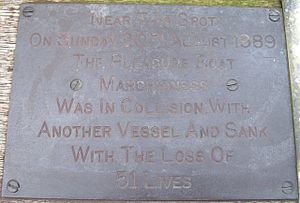
The Marchioness disaster led to many important changes to make the River Thames safer. Following the Clarke report's recommendations, a special search and rescue service was set up for the Thames. In January 2002, the Royal National Lifeboat Institution (RNLI) opened four new lifeboat stations along the river.
The disaster also led to changes in emergency planning and the legal system. The Civil Contingencies Act 2004 was created to provide a better plan for emergencies. The way coroners investigate deaths was also reviewed, leading to the Coroners and Justice Act 2009.
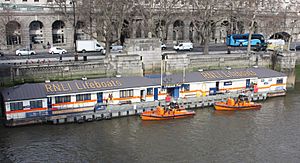
Many people who helped rescue victims were given bravery awards. Eight police officers received special commendations for their actions that night.
The story of the Marchioness sinking has been shown in several TV documentaries and dramas, helping to remember the event and its impact.
In September 1989, a memorial stone was placed in Southwark Cathedral, close to where the accident happened. It lists the names and ages of those who died. Memorial services are held there every year to remember them.
The Bowbelle was sold in 1992 and renamed Billo. Later, in 1996, it was sold again and renamed Bom Rei. That same year, it broke in two and sank off Madeira, with one crew member losing their life.
|
See also
- List of disasters in Great Britain and Ireland by death toll



